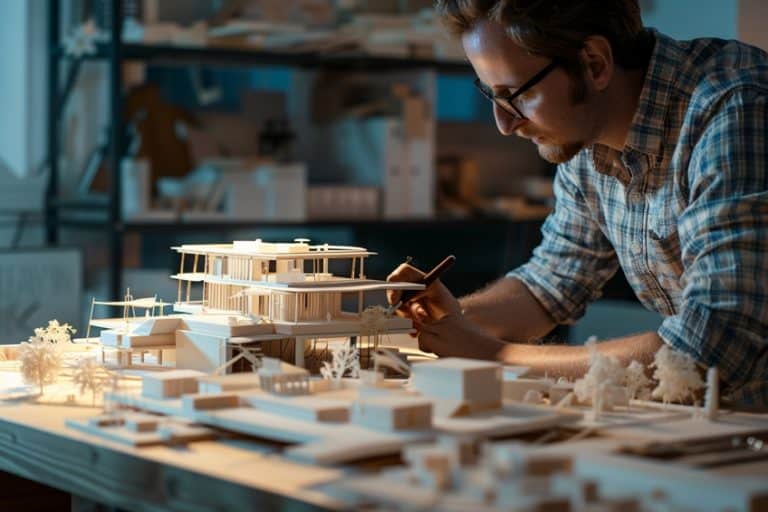Careers in Architecture – Nurturing Your Architecture Career
There are many different careers in architecture that one could choose if one were so inclined, and this article is meant to be an introductory look at a number of different jobs in architecture for those who are interested. If you are interested, then you may appreciate the look into different types of architects and what they do below. Keep perusing this article if you want to learn more about the different careers in architecture that are available!
A Few Careers in Architecture
If you’re interested in one of the many careers in architecture that are out there, then you have come to the right place for an introductory look at some of the many jobs in architecture that can be found. So, if you’ve ever found yourself wondering something like, “What can you do with an architecture degree?”, then look no further as we will answer that question below.
We will specifically look at eleven different architecture careers that one could pursue if one were so inclined. Let’s get started and have a look.
Architectural Designer: The Visionary Creators
In many ways, when we think about standard architecture careers in which a person designs buildings, this is the kind of architect that someone is actually thinking about. These particular architects are those who create and plan out the actual physical spaces that will eventually be constructed. Architectural designers are therefore what most people would simply consider to be an “architect”. This is especially the case with those who are not as familiar with the different fields in architecture.
Architectural designers are often those who may later work with structural engineers to ensure that a structure will stand from a purely logical and structural standpoint.
For this reason, they may not be as well-versed in the mathematics of the engineering process, especially on an immense scale. However, some architectural designers are also well-trained in this particular area. It is ultimately dependent on each individual architectural designer.

Some of the most important skills that are required of an architectural designer include the ability to design, sketch, and conceptualize structures that will not collapse while retaining a certain budget, having an understanding of the particular landscape against which a building is being constructed (such as needing a familiarity with earthquake-resistant materials in an area prone to earthquakes), and an understanding of a myriad of aspects related to buildings, such as sustainability, safety concerns, regulatory laws, and accessibility features and how to implement them.
Furthermore, an education is typically required.
This would require, at the least, a bachelor’s degree in architecture or a similar field, a portfolio, the ability to manage one’s time, a good grasp of mathematics, the ability to manage and organize, and, in the present-day, an understanding of certain architectural and design software as computer-assisted design is becoming increasingly prominent.

If this is something that you too would be interested in pursuing, then there is much that one could do as an architectural designer. This particular profession has had a strong impact on contemporary society as most of the prominent buildings have been designed by architectural designers. This may not be true of the average basic house, as they can be designed by builders, but every major structure was ultimately envisioned by one of these architects.
So, if you’re looking for jobs in architecture, you could certainly do worse.
Urban Planner: Shaping Cities for the Future
Urban planners are a type of career that can be considered related to architecture while not necessarily being an actual architect. However, there have been a great many architects who have also been city planners. For this reason, there are certainly various skills that do translate across the various careers in architecture and related fields. However, urban planners do not focus their attention on individual structures, but rather on far larger urban spaces.
As the name suggests, urban planners are those who design, develop, and maintain city environments to attempt to gear them toward a specific way of being.
Many cities were not truly designed with a central plan in mind, and this is why many ancient cities can feel immensely cramped. Paris, for instance, is a city with a number of famously narrow streets. However, these streets were often designed and implemented well before the development of cars. It is literally impossible to accurately plan what the future will be like as a new technology can always come along and entirely shift the way that things have always been, and so urban planners are meant to attempt to account for as many aspects as possible.

In the present day, this often means an attempt to create sustainable cities through the use of regulations and/or incentives. For instance, if an urban planner were to attempt to shift a city away from a reliance on older forms of electrical generation, it can lead to an attempt to incentivize the installation of solar and wind energy solutions. This could be done by doing something like offering special loans for upgrading a home to be off the grid by having the government pay for part of the installation or by implementing tax breaks for a reduced reliance on a nationwide grid.
Urban planning needs to take many different aspects of urban environments into account when attempting to make these kinds of improvements.
A fantastic example of this includes instances such as the Tanzanian city of Dar es Salaam reducing its road fatalities of children by implementing elements such as speed bumps around schools and lowering the speed limit in similar areas. There have been many successful changes to urban environments that have changed the way those cities operate, and those changes can be in incredibly comprehensive or incredibly small ways. Regardless, there are many different fields in architecture and beyond that can be approached for those who are interested, such as urban planning.
Landscape Architect: Harmonizing Nature and Built Spaces
There are many different types of architects, and landscape architects are perhaps some of the most famous aside from architectural designers. Those who engage in landscape architecture careers are those who specialize in the design of outdoor spaces. This does not necessarily mean gardens, although a landscape architect could certainly be employed in the design of gardens, but the career often means developing spaces such as parks, campus exteriors, green belts, streetscapes, and much more.
Landscape architects do not simply focus on the beautification of outdoor spaces, although that certainly is a common aspect of their day-to-day jobs, but they are instead intended to be knowledgeable about a variety of outdoor-centric issues.
While an architectural designer or structural engineer needs to understand load-bearing structures and ensure that a building doesn’t collapse, a landscape architect needs to understand the correct soil and plant types for a certain area, the best way to ensure effective drainage, the preferable use of local over exotic flora to incentivize a more sustainable approach, and an understanding of how to design exterior spaces so that they can be better used by humans.

In the modern day, landscape architects also play a significant role in environmental conservation. Cities are, famously, all-consuming spaces that obliterate natural landscapes and lead to a variety of issues. For instance, in areas that are prone to flooding, the use of concrete throughout a city is actually a terrible idea as concrete does not absorb water. This is why floods in urban environments are so much more devastating than they once were. The water has nowhere to go, and so it simply fills the cityscape and destroys everything.
A contemporary landscape architect would be expected to attempt to work around issues such as this.
Furthermore, the use of indigenous plants and natural soils can be an important part of local nature conservation. Everyone may want to have roses outside their office, but roses are not necessarily a naturally-occurring plant in the region, and so a focus on plants that are natural can lead to better water conservation too.
In addition, cities are often concrete-filled places, and the addition of a slice of nature can do wonders. No New Yorker could likely imagine their city without the greenery of Central Park. However, this is only one of the many types of architects that one could pursue. There are many more careers in architecture and related fields that could be of interest.
Interior Designer: Crafting Functional and Aesthetically Pleasing Spaces
Interior designers do not usually have much, or any, of a say over the actual design of buildings themselves. For this reason, unlike architectural designers, who design the actual structures, interior designers need to operate within existing spaces to improve them. However, there are instances of structures, predominantly large-scale ones, that include interior designers in the actual design of the building to ensure the best possible interior space, but that is not what your average interior designer would focus on in their daily job.
In general, the purpose of the interior designer is to understand both functionality and aesthetics.
One cannot design a beautiful interior space where no one can actually walk because then that would be a failure of an interior space. Instead, an interior designer must know how best to arrange the space to be as aesthetically pleasing as possible while also being functional. For this reason, if one were to pursue a career in interior design, one would need to understand the constraints of a structure before one can alter it.

For instance, a rented space cannot necessarily have any structural changes as many rentable locations do not even allow the addition of nails in the walls, and so those kinds of constraints become necessary to understand. In addition, an interior designer must understand budgeting, as immense wealth can lead to extravagant interior spaces, but an interior designer should be able to turn even a modest home into a beautiful space.
The reason that interior designers are so important is because of the simple reason that buildings are actually constructed with a purpose. For instance, houses are places where human beings live.
No one wants to live in a poor interior space, although many do through necessity. One can simply see the difference between a cleaned kitchen versus a messy one filled with unwashed dishes to see the difference that a good interior space can have on a person’s mood. This is only one of the reasons why interior design is such an important aspect of a building, and different types of interior spaces can have different impacts on their occupants, such as the calming nature of a minimalist space or the cozy atmosphere of a well-prepared reading nook.
Architectural Technologist: Bridging Creativity and Technology
An architectural technologist, which is a far more contemporary term than some of the others that have thus far been discussed, is one of the many types of architects that one could become if one were to choose from the myriad of careers in architecture that are available to us in this world. In the world of architecture, the architectural technologist is considered to be the one that bridges the gap between the creative and technological sides of architecture.
In the computer age in which we presently exist, digital technology has become increasingly important.
Many modern-day structures are constructed around certain types of software that allow for computer-assisted architecture. This can involve the use of various digital fabrication technologies that aid architects in allowing for simulations that can show completed structures and how they might respond to natural elements, such as earthquakes or high wind force.

It has become necessary in the modern age to understand how a tall building will respond to the kinds of winds that can be found high above us where a skyscraper might reach, and it would be better to make use of computer simulations than to build something and then hope that it withstands those natural forces. Architectural technologists are often integral in the evaluation of construction sites, such as by ensuring that the correct materials are being used, legal processes are being adhered to, and environmental elements are being taken into account.
In the present day, their role has become more prominent than ever, and so when it comes to jobs in architecture, a role as an architectural technologist is certainly one to consider among the many careers in architecture that could be chosen.
Historic Preservation Specialist: Safeguarding Cultural Heritage
The design of new buildings is always a fun and exciting thing, but the problem with a planet is that there is, by its very existence, a finite amount of space. In addition to this, buildings sometimes lose their functionality and purpose, and so many structures are eventually torn down to make way for other structures.
Most buildings in our world are not necessarily historically or culturally significant, but some of them are, and those sites need to be protected.
It can be a difficult thing to do because historical buildings, like any building, requires upkeep, and that means that there are costs associated with it. This can mean that it is easier to simply demolish a historical site rather than attempting to preserve it, but this is where historical preservation specialists come in. These specialists are there to preserve, conserve, and protect these kinds of structures, and this can mean ensuring that they are not demolished or even that they are adapted for the new world.

A good example of this being done is the Steinway Tower. This supertall skyscraper in New York City was built atop the historic Steinway Building, and so the original was preserved while the new was constructed atop it. This is a particularly interesting success story. However, there have also been failed aspects of preservation, such as the Abraj Al Bait complex in Mecca, Saudi Arabia.
This building is situated on the site of an old Ottoman citadel from the 18th century.
The citadel was demolished to make way for the hotel complex that now stands in its place, and the decision infuriated many Turkish people who felt that their heritage was being destroyed. This is why preservation is important, and historic preservation specialists are of integral importance for this very reason.
Sustainable Design Consultant: Building for a Greener Future
While there are many different types of architects, sometimes a career in architecture can also mean being a consultant who does not necessarily design anything but instead serves as an aid to those who do. When it comes to the future, it has become increasingly important for sustainability to be a major aspect of construction going forward, and this is where sustainable design consultants enter the scene.
This profession within the larger architectural field is an important one that entails collaborating with architects and other positions within design and construction to ensure that various elements are as sustainable as possible.
This can entail advising on the best types of materials that can be used for a certain area, the sources of energy that could be optimized, the way in which interior elements like toilets could be supplemented with gray water systems, and so on. There are many different eco-friendly practices that need to be adopted in the world that we now live in, and sustainable design consultants exist in an attempt to combat the existential threat of climate change.

So, those who choose this particular job in architecture are also those who need to understand the technologies and materials that can be used to make a structure more sustainable than it would have been otherwise. This can lead to consultants clashing with designers, managers, and contractors as the less eco-friendly option tends to be the easiest (and often cheapest) one to implement.
However, sustainability is an important part of construction going forward, and many structures that are currently being designed actively attempt to be eco-friendly designs because that is, quite simply, a better way to be.
Building Information Modeling (BIM) Specialist: Enhancing Collaboration
A building information modeling specialist, or BIM specialist as this will hereafter be referred, is those who make use of BIM software to ensure that the collaborative efforts between architects, engineers, managers, and contractors are going ahead as planned.
This technology entails the use of software that can create graphic models and data that are then used to ensure that design and construction are going ahead as planned.
BIM specialists use this technology to generate these various models and reports that keep track of the current construction, such as keeping detailed reports on the present state of construction, the costs associated with it, the time that may be lost or gained because of a variety of factors that may be out of the control of managers (such as poor weather), and this all ultimately aids in communication between the various fields within design and construction. This becomes necessary the larger the project becomes.

While a simple residential project likely does not need a BIM specialist to help keep everything on track, a large commercial structure definitely does. This can aid in decision-making processes, such as how to efficiently approach various aspects of design and implementation.
This kind of software can also be used to reduce risk and wasteful practices, and so this field in architecture becomes incredibly important as the complexity of construction increases.
Construction Manager: Overseeing Projects to Reality
Construction managers are some of the most important figures in the process of the construction of buildings. While many of the different types of architects focus on the design of structures, construction managers focus on the actual construction of said structures. This means that they are the ones who see to it that the building is finished on time, that milestones are met, that construction workers are properly assigned to where they should be, and that health and safety precautions are being taken throughout the construction site.
The basic idea behind a construction manager is that they are in charge of overseeing the design’s journey into being a real building, and while there have been instances of architects also serving as construction managers, this is decreasingly the case.
In ancient times, architects were generally in charge of the entire process, from conception to completion, but the diversification of the various careers in architecture has led to a diversification of skills, and the skills of an architect do not necessarily relate to the skills of a construction manager. Construction managers are typically associated with the nitty-gritty aspects and need to coordinate the construction laid out by architects, and this can also often mean bringing certain high-minded ideas to a workable level.

There is sometimes an antagonistic relationship between architectural designers and construction managers as the former thinks in the abstract and the latter thinks in the concrete. Some of the other important duties of construction managers include aspects such as having actual practical knowledge of the processes of construction, needing to negotiate with suppliers to maintain a certain budget, to actually use rather than theorize about new technologies, and to ensure that everything is completed according to regulations and labor laws.
This means that it can also be a difficult and high-stress job that can entail unpredictable events, such as needing to work around unfavorable weather conditions.

However, construction managers are some of the most important parts of the design and construction process, and because construction often takes considerably longer than design, there is inherent job security in the role. You can’t exactly fire a construction manager halfway through a project. There is also significant room for career advancement, the ability to work on a variety of different types of projects in a variety of different locales, and it involves working with people. So, if these are elements that you would want to see in a career, then perhaps this may be for you too.
Academic and Research Careers in Architecture
While we tend to think of architects as those who design buildings, this is not always the case. Whenever something more abstract needs to exist, put your faith in academia to make it so! For this reason, there are careers in architecture that do not necessarily entail the design of buildings that will actually be built. However, it is often in academic settings where many innovations are created.
To become an academic architect, one generally needs a far higher education than simply a bachelor’s degree in architecture.
This is why many academic architects instead have Master’s or Doctoral degrees in architecture, and these architects are those who focus on teaching the next generation of architects while also conducting research to determine new methods, technologies, and everything else that goes into architectural design. While a career in academia can often entail far less actual design, it does involve research and development of what can later be used in design as academics are expected to publish their work.

This is also why many academic architects will also collaborate with other fields to develop new and innovative ways of approaching architecture. For instance, it is only through an understanding of botany and biology that one can best understand ways of designing exterior spaces that make use of plants and natural elements.
Some of the most fascinating advancements to come out of architectural academia include 3D printing, robotics, biophilic design, and parametric design.
Each of these can be developed and researched in academic environments while being extensively tested as variation upon variation is experimented on to determine the best way for it to be used in the field. It is through this that new technologies can be created and prepared for real-world use, and so for those who prefer the abstract over the concrete, this could be a good career in architecture to pursue.
Entrepreneurial Opportunities in Architecture
While careers in architecture generally entail becoming something like an architect, or one of the many different types of architects that we have examined over the course of this article, but this is not necessarily the only avenue down which someone can tread. There are also many other careers in architecture that one could pursue, such as the various entrepreneurial opportunities that exist within this space.
In a term still related to actually being an architect, one can start one’s own architectural firm or work as a freelancer, but this can be difficult to do in the early days of a career as an architect as many prefer to work with those who have experience in the field rather than just a degree.
However, certain strands, such as landscape architecture and interior design, which are often considered to have lower stakes than designing a building (which could collapse if it was poorly designed), are easier areas to break into from an independent perspective. In addition to this, there are possible careers in architecture that do not necessarily involve being an actual architect, such as being on the management side or working with architects on the non-architectural side of the architecture business.
However, choosing any path can be a difficult one, but it certainly is possible. Although, those who tend to have the most success with their own practice are also those who have already established a name for themselves in the one or more of the many fields in architecture. There are many success stories though. For instance, there are people such as Eric Reinholdt, who sells floor plans and templates, and also operates a YouTube channel to help designers.
In addition, there are businesses such as the China-based Shulin Architectural Design that have worked to revitalize rural environments.
One could even look at famous examples of people like Frank Lloyd Wright, who started his own firm after establishing himself and went on to become one of the most prominent architects in the United States. There are ultimately many architecture careers that can be adopted to make a name for oneself in the architecture world, but there are also opportunities to do things your own way and to do it all yourself.

It depends on what you want to do and how you would prefer to approach these kinds of aspects of life. However, there are many careers in architecture that one can choose from in this world, but they are all tailored to different kinds of people. So, it’s best to know who you are and how you want to approach it.
And so, we end our look at the many careers in architecture that are available to those who are interested. So, what can you do with an architecture degree? It turns out that there are quite a number of different things that one can do with one of those degrees. We have looked at only eleven of the different architecture careers that one could pursue, but if you do want to actually pursue one, you should look more closely into those that interest you. You can’t do it all, after it. It is often best to specialize and fully focus on what you love.
Frequently Asked Questions
What Is an Architect?
An architect is a very broad label that refers to a great many different types of architects. However, in general terms, an architect is a person who designs structures of some kind, such as buildings, parks, and so on.
How Many Types of Architects Are There?
There are numerous different types of architects in the world. There are architectural designers, landscape architects, interior designers, and many more. Not all architects necessarily design buildings, but they do all generally have a hand in designing structures in some capacity.
What Can You Do With an Architecture Degree?
There are many different careers in architecture that one could apply oneself to if one were to attain an architecture degree. While one does not necessarily need a degree to design a building, most people will not hire someone as a designer of a building without one. For this reason, a degree becomes necessary if one wants to pursue a career in architecture.
Can a Building Be Constructed Without an Architect?
A building can be designed without an architect, as there are many buildings that do not generally use one, such as many residential structures. However, the more complex the design, the more necessary one becomes. However, in small construction projects, a builder can likely design and construct a house without actually being an architect. However, some places do have more regulations than others when it comes to topics such as this.
When Did Architecture Become an Academic Field?
The earliest academic location that provided proper architectural education was in 1671 in France. Before that, the design of buildings was generally viewed as something that one learned through apprenticeships. This was common with most skilled careers. You would become the apprentice of a master and learn from them. The formalization of architectural education would only come later. It is the most common method used today though.
Justin van Huyssteen is a freelance writer, novelist, and academic originally from Cape Town, South Africa. At present, he has a bachelor’s degree in English and literary theory and an honor’s degree in literary theory. He is currently working towards his master’s degree in literary theory with a focus on animal studies, critical theory, and semiotics within literature. As a novelist and freelancer, he often writes under the pen name L.C. Lupus.
Justin’s preferred literary movements include modern and postmodern literature with literary fiction and genre fiction like sci-fi, post-apocalyptic, and horror being of particular interest. His academia extends to his interest in prose and narratology. He enjoys analyzing a variety of mediums through a literary lens, such as graphic novels, film, and video games.
Justin is working for artincontext.org as an author and content writer since 2022. He is responsible for all blog posts about architecture, literature and poetry.
Learn more about Justin van Huyssteen and the Art in Context Team.
Cite this Article
Justin, van Huyssteen, “Careers in Architecture – Nurturing Your Architecture Career.” Art in Context. August 16, 2023. URL: https://artincontext.org/careers-in-architecture/
van Huyssteen, J. (2023, 16 August). Careers in Architecture – Nurturing Your Architecture Career. Art in Context. https://artincontext.org/careers-in-architecture/
van Huyssteen, Justin. “Careers in Architecture – Nurturing Your Architecture Career.” Art in Context, August 16, 2023. https://artincontext.org/careers-in-architecture/.









